Homa Bay farmer makes boss moves in poultry farming
By Noven.Owiti, February 22, 2022A dusty one-kilometre murram road off Katito-Homa Bay highway leads us to Nick Akoko’s poultry farm in Kiltal village, Karachuonyo Sub-County.
The enterprise is leading the pace in poultry matters, producing improved kienyeji (indigenous) breed chicken both for commercial and household consumption in Homa Bay County.
Akoko says his inspiration to start poultry keeping was driven by a desire to generate direct income for himself and boost supply of chickens and promote food sufficiency locally. “I started with a seed capital of just Sh10,000 in February last year with about 10 birds before eventually scaling up the stock in subsequent months,” he recalls.
The farmer started off with three months old birds acquired at Sh 500 each then added to the stock more birds from the proceeds realised from the disposal of the first batch of 30 chickens. He used the remainder of his earnings to construct a modern poultry structure as he set his eyes on growing the business steadily.
Exactly one year later, the venture looks promising for Akoko as he hopes for the business break even.
The venture rakes him good fortunes and, in every sale, he can take home up to Sh40,000. He disposes large live birds from five and above months old when they weigh about two kilogrammes.
His farm has established a fair market base, with customers majorly local hoteliers and caterers placing orders to get deliveries for their eateries and public events respectively. He also sells to traders in nearby markets and individual families. “The birds fetch good prices locally. The price of chicken weighing between two and three kilogrammes ranges between Sh650 and Sh1,000 depending on the demand trends,” says Akoko.
The farmer mainly keeps Kenbro and rainbow rooster chickens. Kenbro chicken breed is a free-range bird that is resistant to disease and possesses a well-rounded conformation. These birds can be used for sustainable or commercial farming for meat or eggs.
The birds can be managed as a free-range with minimum supplementary feeding and get ready for consumption or sale after 10 to 14 weeks.
Akoko says he chose the Kenbro breed because of its proven hardy and disease resistant qualities.
Proper feeding
Among the birds in his poultry farm are brood stock that produce eggs he hatches to increase production. On average, the farm can hatch 100 eggs in every production cycle, which takes 21 days.
He is yet to acquire his own incubator and as a result, he hatches the eggs at Sh20 each at a hatchery in the nearby Kendu Bay township.
The birds are fed at least twice a day until midday, and then they are left to feed on free range from 2pm to 4pm.“Proper feeding and high standards of hygiene must be given keen attention for better yields. I give the birds mixed and well-portioned feeds to boost their growth rate and production,” he says.
Similarly, they are vaccinated up to the fourth month of growth to reduce chances of disease. He has crafted a chart for routine vaccination of the birds starting from day one to four months.
Akoko points out that any sign of disease outbreak among the birds must be handled cautiously and promptly to avoid wide spread among the stock. “I have managed to contain frequent common disease infections through timely vaccination and proper hygiene. I keenly follow the vaccination table to help me administer the right medication to the birds,” the farmer explains.
On matters of feeding, Akoko’s farm does its own feed formulation in order to cut the cost of buying feeds from elsewhere. “The cost of chicken feed keeps going up and this affects production cost for farmers. Therefore, I decided to generate my own for use on the farm. The feed surplus I sell to my fellow farmers and earn extra income,” he says.
Key challenges
Akoko cites poultry disease outbreaks, fluctuating poultry market prices and inadequate access to agricultural extension officers locally as key challenges to his farming activities. At one time, he lost nearly 25 three- to four-month-old birds to coccidiosis (deadly poultry disease that presents itself with signs of decreased growth rate, high percentage of visibly sick birds, severe diarrhoea, high mortality, depressed water and feed consumption, weight loss, development of culls and decreased egg production).
Encouraged by the sweet returns, he intends to expand his production by increasing the number of birds to about 700 in anticipation of more profits.
Aside from poultry, Akoko practices horticultural farming on a two and half-acre farm to supplement his earnings. He grows arrow roots, tissue culture bananas, tomatoes, onions, oranges, paw paws and mangoes.
He uses one acre for the production of arrow roots while the remaining one and half acres is for growing the other fruits.
From the horticulture component, the farmer earns added income.
For Akoko, diversification in farming comes in handy with lucrative gains. For instance, he says the various components supplement each other hence the stability of the agribusiness is guaranteed.
For better and efficient marketing of farm products, he uses digital platform to reach out and keep close contact with his potential customers.
Further, Akoko explains that farming requires personal involvement to achieve desired results. “The big lesson I have learnt is that farming is an activity that also requires utmost commitment and perseverance to realise success. You must be physically present to attend to farm activities,” he s tates.
On the other hand, he says farming has turned around his lifestyle and hence he leads an average livelihood just like anyone engaged in formal employment.
